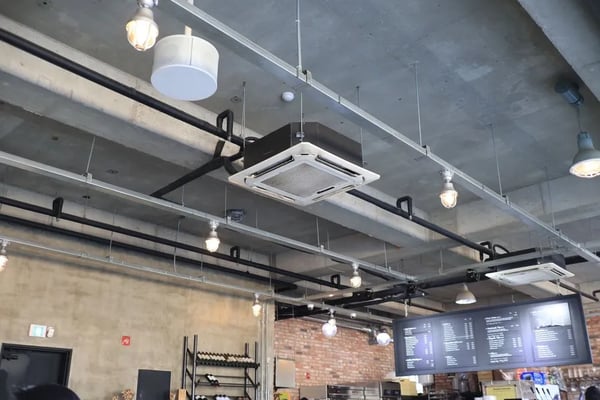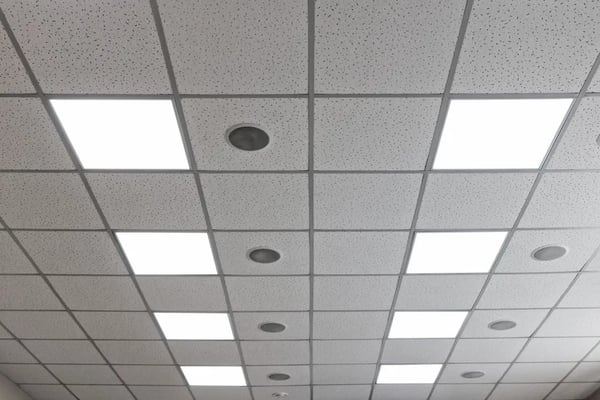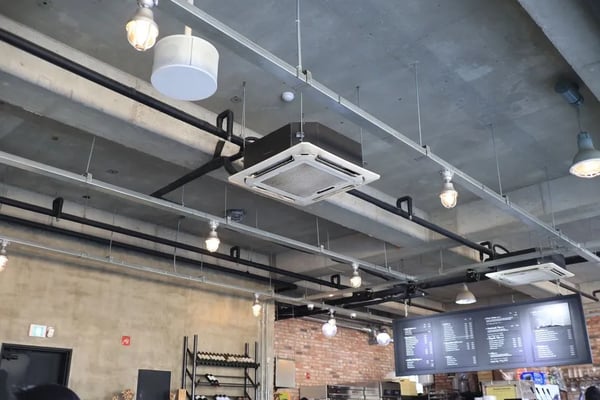A ceiling can be defined as a suspended interior surface that covers the upper limits of a room. Ceilings are not structural elements, but rather the finished surfaces beneath a roof or concrete slab. Many types of ceilings are used in buildings, but the most common are exposed and suspended ceilings.
Ceilings provide space for mechanical, electrical and plumbing (MEP) installations. These are useful spaces for installing components such as speakers, lighting fixtures, fire and smoke detectors, automatic sprinklers, etc. This article makes a comparison between exposed ceilings and false ceilings, describing the advantages and disadvantages of each option.
Design an ideal MEP layout according to your ceiling type.
Exposed ceilings
Exposed ceilings are also known as open ceilings or open plenums. In this type of ceiling, all structural and MEP systems are exposed, whether in normal colors or painted. Open ceilings are gaining popularity in almost every domain: this architectural trend gives an industrial look, while also making rooms more spacious thanks to the increased height. Exposed ceilings offer several advantages:
- Increased natural lighting with skylights : This effect is especially prominent if your building faces south, as this is the side that receives the most sunlight in the northern hemisphere.
- Modern Interior Designs: An exposed ceiling allows for creativity in design with custom lighting and piping. Mechanical and electrical installations can become decorative elements, not just distribution systems.
- Extra space : A traditional closed ceiling often makes a room appear much smaller than it actually is, and an exposed ceiling gives the effect of extra space, even in a crowded room. Having exposed ceilings also provides extra space for hot air to rise, making rooms cooler – this can be beneficial in hot climates.

However, open ceilings require planning. Poorly designed and constructed ceilings will develop problems related to acoustics and MEP characteristics. Following are some disadvantages of exposed ceilings:
- The “unfinished” appearance of an exposed ceiling is actually the result of skilled labor: Exposed ceilings lack many components used in false ceilings, but don't assume they require less labor. In existing buildings with false ceilings, old ducts and plumbing are usually dirty and not aesthetically pleasing, requiring a lot of work and money to achieve a beautiful “exposed” appearance. Additionally, ducts and pipes must be painted for exposed ceilings, which requires specialized labor.
- Higher labor costs: The growth of the construction industry requires an increasing supply of skilled labor, and contractors face a shortage of skilled workers in active markets like New York. Open ceilings may require fewer materials than false ceilings, but these savings are typically offset by the labor-intensive tasks required for an open plenum.
- Solid considerations: Exposed ceilings require acoustic treatment, as they do not have the sound absorption effect of suspended ceilings. Surfaces on exposed ceilings often create an echo chamber, requiring solutions like spray-on acoustic materials.
- Exposed ceilings can increase energy costs: Although exposed ceilings have a lower material cost, they are less effective as a barrier against heat transfer. This leads to increased heat gain in the summer and heat loss in the winter, increasing HVAC costs.
- Demanding maintenance: Exposed ceilings require frequent cleaning and repainting, which is not necessary with false ceilings. Overall, false ceilings are more economical.
Exposed ceilings can create an aesthetic vibrancy in buildings, creating a productive and attractive space for employees and tenants. However, meticulous planning is required to achieve good performance and maintain pleasant working conditions. It's easy to assume that an “informal” exposed ceiling is cheaper than a suspended ceiling, but the reality is often quite different.
Suspended Ceilings
False ceilings are sometimes referred to as suspended ceilings or suspended ceilings. As the name suggests, they are suspended from the structure above, usually a roof or slab. This creates a space between the bottom of the structure and the top surface of the ceiling.
False ceilings are hung from supports attached to the underside of the roof or slab. These brackets support a series of interconnected metal sections, forming a grid or beam system into which the panels can be fitted. These tiles can be removed to access the ducts and pipes above.
The following are some of the main advantages of false ceilings.
- Concealment of ducts, tubes and wires: Instead of performing expensive repairs and painting, suspended ceilings can hide visual imperfections that do not affect the performance of MEP installations. This type of ceiling allows easy access to the above systems for maintenance – simply remove a panel to carry out repairs and replace it when finished.
- Easy and quick installations: False ceilings can be easily installed in offices and homes. In businesses, where minimal work interruption is required, a false ceiling can be completed quickly by professional installers.
- Soundproofing: Fiberglass false ceilings will block external sounds. Unlike plasterboard or plasterboard ceilings, false ceilings provide better acoustic qualities, so noise pollution from upper floors is considerably reduced.
- Easy installation of electrical components: Lighting fixtures, air vents and other appliances can be easily installed between ceiling panels. Many fixtures are sized to fit into a panel slot – typically 2' x 2' or 2' x 4'.
- Fireproof: Fire resistant suspended ceilings can provide up to an hour of protection during a fire to allow for evacuation. Additional fire barriers can be installed above the suspended ceiling to increase the level of protection.
- Insulation: A suspended ceiling provides insulation while reducing conditioned spaces. Energy bills are reduced as the space to be heated or cooled becomes smaller.

However, as with any construction decision, false ceilings also have their limitations. Following are some of its main disadvantages:
- Loss of space: A clear disadvantage of false ceilings is the reduction in the height of internal spaces by several centimeters or feet. As a result, spaces can appear more cluttered to occupants.
- A false ceiling can hide construction problems: When buying or renting a property with false ceilings, be sure to inspect the facilities covered by them. Remove panels and inspect the space to ensure there are no structural deficiencies or damaged MEP components.
- Deterioration: False ceilings tend to sag and show signs of discoloration over time. Therefore, frequent maintenance is required to maximize its useful life.
False ceilings tend to have a higher material cost than exposed ceilings. However, these additional costs are offset in the long term by lower energy costs and easier maintenance. Renovations and reconfigurations are also simpler and less expensive.
Conclusion
Engineering decisions are often characterized by having multiple options with advantages and disadvantages, and this applies to ceiling selection.
An exposed ceiling uses fewer materials while increasing interior space, and its industrial appearance may be preferred by architects in some applications. However, exposed ceilings are more labor and maintenance demanding and tend to increase HVAC expenses.
False ceilings hide MEP installations and their appearance is less important as long as they function correctly. Although the material cost of a false ceiling is higher, it saves on labor and maintenance. HVAC systems also work more efficiently since unwanted heat transfer through the ceiling is reduced.

